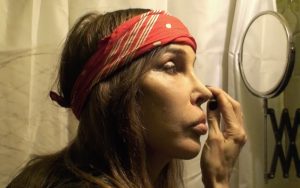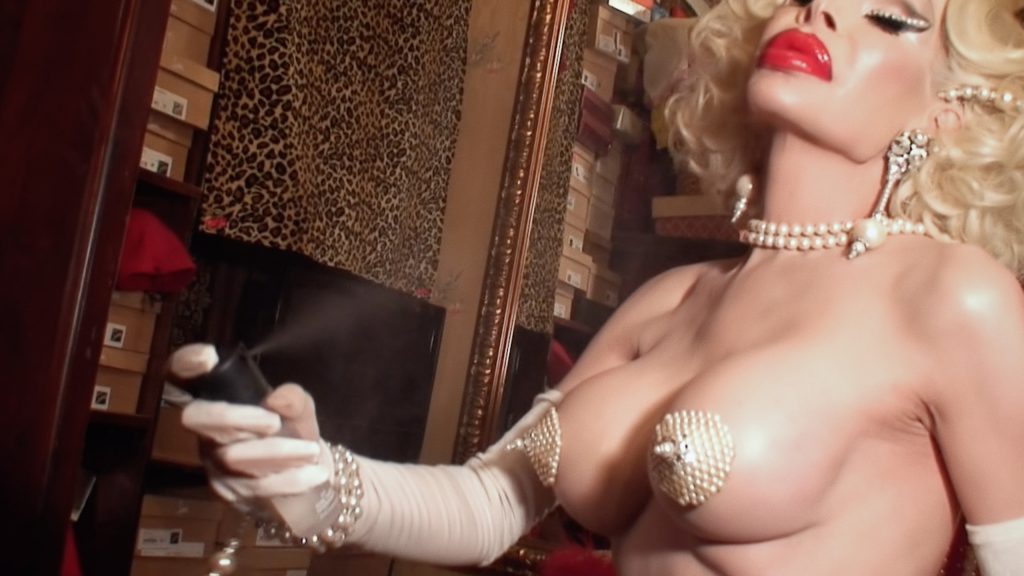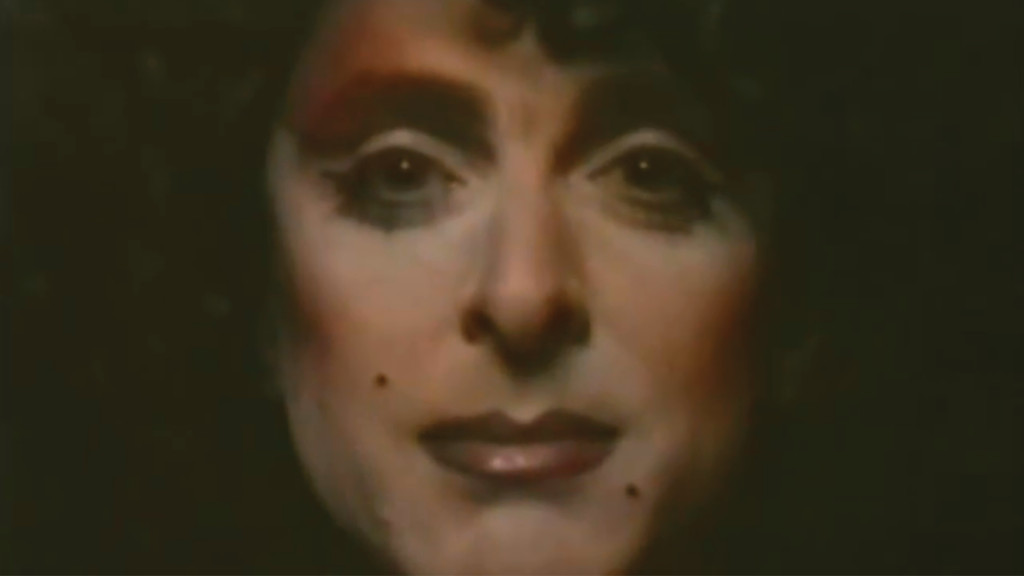September 18, 2020
by Carla Hay

Directed by Gustavo Sánchez
Some language in Spanish with subtitles
Culture Representation: Taking place mostly in New York City, the documentary “I Hate New York” (filmed from 2007 to 2017) about four artistic transgender or transsexual people who have been longtime residents of New York City, with additional commentary by cisgender people who have been part of the New York City underground artist scene .
Culture Clash: Several people in the documentary talk about experiencing transphobia and how rising rents and gentrification have changed New York City’s artistic scene for the worse.
Culture Audience: “I Hate New York” will appeal mainly to people interested in LGBTQ issues and the New York City artistic scene from the 1990s to 2010s.

The artistic people in the provocatively titled documentary “I Hate New York” don’t really hate the city all the time. It’s more like a love/hate relationship. They love the city’s endless choices when it comes to art and culture. They love how people can come to New York and find more acceptance than they would in more conservative cities. But they also hate how the city has become too expensive for struggling artists. And they hate how the way transgender people are still targets for hate crimes and still have to fight for a lot of basic rights that cisgender people take for granted.
Directed by Gustavo Sánchez over the years 2007 to 2017, “I Hate New York” takes a fascinating, raw and emotionally up-and-down look at four transgender or transsexual people who have been longtime New York City residents and part of the city’s entertainment and artistic scene. The four stars of the movie are:
- Amanda Lepore, a transsexual woman who has a Marilyn Monroe-inspired image and who is best known for being a nightlife personality and model.
- Sophia Lamar, a transsexual woman who is a Cuban immigrant, as well as a singer, actress and dancer known for her edgy entertainment.
- Chloe Dzubilo, a transgender woman who became the lead singer of the punk band the Transisters and an outspoken AIDS activist.
- T De Long, a transgender man who’s an aspiring rapper, DJ and artist (with the stage name TJ Free) whose gender transition is documented in the film.
All of them candidly tell their personal stories and struggles about being a transgender artist in New York City. A description shown in the beginning of the documentary describes the movie this way: “It is an intimate portrait of four heroines living at the margins of activism, transgender culture and nightlife.”
Also weighing in with their opinions are Bibbe Hansen, a former Andy Warhol Superstar; nightlife personality/promoter Linda Simpson; photographer/activist iO Tillett-Wright; filmmaker Katrina Del Mar; promoter Geordon Nicol; and performer/musician Kembra Pfalher.
Lepore and Lamar used to be very close friends came up in the 1990s nightclub scene together. They even sued the nightclub Twilo together for transgender discrimination in 2001, when the club fired them as dancers for not being “real women.” But then, sometime in the late 2000s, Lamar and Lepore had a falling out and they no longer speak to each other.
Dzubilo and De Long had a different kind of connection: They became a romantic couple as De Long (who used to be known as Tara Jo) was transitioning into being a man. Their love story in the movie is touching and tragic.
What all four have in common is that they came to New York City to reinvent themselves because they weren’t really accepted in the places where they lived before. They all had different struggles with their gender identity and experiencing transphobia. And they all found their artistic voices by living in New York City.
Lepore, who is originally from New Jersey, has been open about her past as a dominatrix before she was able to make a living as a nightlife personality. In the documentary, she talks about knowing as a child that she is female. As a teenager, she secretly took female hormones so her body could match her gender. And at 17 years old, the father of her then-boyfriend paid for her sex confirmation surgery. She married the boyfriend, but the marriage didn’t last.
Broke and desperate after she left her husband, Lepore says, “I was working as a dominatrix because I didn’t have any job skills. I wasn’t making enough money doing nails and little jobs, which weren’t paying the bills … I was able to make money as a prostitute without having sex.” One thing that worked out for Lepore was that she was able to live in a hotel that used to be managed by an ex-boyfriend, and her rent pretty much stayed the same for years because the hotel’s management gave her a special discount due to that relationship.
As for all of her plastic surgery, Lepore lists the alterations she’s done to her body, including breast augmentations, a nose job, rib reductions and silicone injections in her hips, lips, cheeks and buttocks. She’s also had her eyes tilted and her hairline pulled down. Just like a lot of women who’ve had surgery to make their breasts bigger, Lepore likes to show that she thinks it was money well-spent, by having a tendency to wear low-cut tops or display her naked breasts in public.
Lepore says she’s all about glamour and escapism. And she still proudly identifies as a “club kid.” The documentary shows her getting dolled up and hobnobbing in nightclubs, usually accompanied by another transgender friend. Fellow nightlife diva Simpson says of Lepore: “Amanda’s fame … is sort of a by-product of what she became.”
If Lepore is about glamourous escapism, Lamar is the opposite: In the documentary, Lamar says, “Club kids are dead,” and she says her artistry is more about realism and being a contrarian. But at the same time, Lamar admits that she enjoys manipulating the truth when it comes to her artistic expressions: “People are in love with a liar,” she says. “People like being lied to.”
Whereas Lepore prefers dance music, Lamar’s preferred music has a rock edge. The documentary includes some footage of Lamar performing her style of avant-garde rock in a nightclub. According to Lamar, she began calling herself Sophia at the age of 13, which is somewhat unusual since a lot of transgender people come out as transgender at a later age. She explains why she changed her first name at such a young age: “Some things are punk rock before they’re punk rock.”
Lamar (who speaks English and Spanish in the movie) also describes her difficult journey when she immigrated to the United States from Cuba. She says that the boat that she and her family came in capsized. They and other passengers had to be rescued by helicopter. She got her chosen surname Lamar because “el mar” means “the sea” in Spanish.
The contrast between Lamar and Lepore is also obvious in how they view nostalgia. Lepore clearly idolizes Marilyn Monroe (she often dresses like how Monroe looked in the 1950s) and she doesn’t mind talking about her heyday as a “club kid.” Lamar has this to say about why she doesn’t like to dwell on the past: “Nostalgia is private … like masturbation. Nostalgia is like a cancer.”
Nightlife promoter Nicol comments in the documentary: “Sophia Lamar is probably one of the most important nightlife people in New York.” And although former friends Lamar and Lepore no longer speak to each other, Lepore says they are still connected because they still go to the same nightclubs and still know a lot of the same people. Whichever style of performance art that people prefer, it’s clear that there’s room for both Lepore and Lamar in New York’s nightlife.
Although neither and Lamar nor Lepore go into details about what went wrong with their friendship, Lepore hints that Lamar was the one who ended it. Lepore comments in the documentary about their estrangement: “I was upset about it … I’ve moved on … It did hurt at first … It was more her than me.”
While one relationship unraveled among two of people starring in this documentary, another relationship blossomed. Dzubilo describes herself a kid who came from a working-class Connecticut family and grow up around a lot of “white, New England, conservative small-town stuff.” Dzubilo comments in the documentary: “I went to private school on a scholarship, but I always had this deep internal life.”
She moved to New York City in the early ’80s when Studio 54 reopened under new owners after original owners Steve Rubell and Ian Schrager were imprisoned for tax evasion. Dzubilo says when she first lived in New York City, she felt he felt “gobbled up” by the city. She says she became a “wild child” and had a boyfriend who was a drug dealer. The documentary includes footage of Dzubilo as lead singer of the Transisters, a punk band consisting of all transgender women.
Dzubilo attended the Parsons School of Design and received an associate degree in Gender Studies from the City University of New York City College in 1999. But she also went through tough times, including being homeless and being diagnosed as HIV-positive, which led to her being a passionate AIDS activist. At the time she filmed this documentary, Dzubilo also talked about having other health issues, such has having debilitating problems with her bones.
It isn’t made clear in the documentary how Dzubilo and De Long met, but the movie shows De Long in the days when De Long was living as a woman named Tara Jo and she was an aspiring rapper. De Long, as Tara Jo, says that when she was a child, her dream was either to be a Hollywood star or a baseball star.
De Long also has a lot to say about how New York City has changed since she moved to the city in the mid-1990s from rural Illinois: “I wish New York could be more accessible the way it used to be, more of a place where artists can come and sort of start and not be in debt and have a chance to live here. Unfortunately, it’s a tough place to start.” De Long continues, “The problem with the underground is there’s no money in it. And you get to a certain age when you can’t do it for free anymore.”
Dzubilo and De Long became a couple when De Long was living as a transgender man. It’s mentioned in the documentary that De Long has since made the full transition by having the operation. In case people don’t know what happened in Dzubilo and De Long’s relationship, that information won’t be revealed in this review. However, the documentary does show what happened, and it’s the most emotional part of the movie.
One of the scenes that shows an example of things that cisgender people take for granted is when Dzubilo and De Long jubilantly describe how they took a trip outside of the United States as a transgender couple. They were able to get through the customs checkpoint with their passports without being questioned or harassed because they’re transgender. They talk about how that type of gender acceptance, which cisgender people don’t have to think about when they show their identification, was a huge milestone for them.
All four of the transgender stars in this movie became trans activists, with Dzubilo being the most politically active of the four. Lepore has this to say about her trans activism: “What I do is a statement. I help people in my own way.”
“I Hate New York” (which is Sánchez’s feature-film debut as a director) has a lot of raw-looking hand-held footage, but there’s also some artistic shots, especially of the nightlife scenes. And because the movie was filmed over 10 years, it’s a compelling journey into the lives of these four transgender people. “I Hate New York” isn’t about disdain for America’s most-populated city but rather hate for any transphobia they’ve experienced and New York City’s increasingly difficult financial barriers for struggling artists. However, the transgender people who star in this documentary admirably show how they’ve been able to rise above the hate.
1844 Entertainment released “I Hate New York” on digital and VOD on September 1, 2020. The movie was originally released in Spain in 2018.

